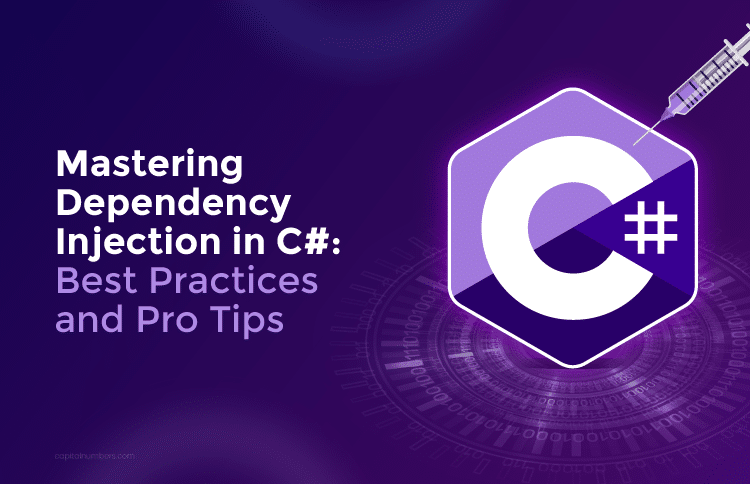Mastering Dependency Injection in C#: Best Practices and Pro Tips
Table of Contents
Mastering Dependency Injection (DI) in C# is essential for building clean, scalable, and maintainable applications. DI makes it easier to split your code into smaller, more flexible components, which improves testing and simplifies updates. However, as your project grows, managing dependencies can become tricky and lead to cluttered code if not handled properly.
That’s why understanding how to structure and manage your dependencies from the start is so important. A thoughtful approach to Dependency Injection can save you from headaches down the line and help your application stay agile as it evolves.
I will discuss some practical tips and best practices for using Dependency Injection in C#. Whether you’re new to DI or looking to refine your current approach, these insights will help you keep your codebase organized, maintainable, and ready to scale with your growing project needs.
How to Manage Dependencies in C# Applications?
Effectively managing dependencies in C# is essential for building scalable and maintainable software. Here’s how you can approach it:
Manual Dependency Wiring
- You explicitly create and pass dependencies in your code, often via constructors or properties.
- Works well for small projects or simple object graphs.
- Becomes hard to maintain as the project grows due to tight coupling and repetitive code.
Using DI Containers
- Automate the creation and injection of dependencies.
- Reduce boilerplate and improve code testability.
- Popular containers in C#: Microsoft.Extensions.DependencyInjection (built-in), Autofac, Ninject.
Use Interfaces and Abstractions
- Program against interfaces, not concrete implementations.
- This promotes loose coupling, allowing easy swapping of implementations.
- Example:
public interface ILogger { void Log(string message); } public class ConsoleLogger : ILogger { public void Log(string message) { Console.WriteLine(message); } }
Use Microsoft.Extensions.DependencyInjection
- The default DI container in .NET Core and later versions.
- Supports service lifetimes:
- Transient: New instance every time requested
- Scoped: Same instance within a request scope
- Singleton: Single instance for the app lifetime
- Simple registration example:
services.AddTransient<ILogger, ConsoleLogger>(); services.AddScoped<IUserRepository, UserRepository>(); services.AddSingleton<IConfiguration>(configuration);
By following these steps and using the right tools, you can keep dependency management in your C# applications clean, flexible, and easy to maintain.
Want to build a high-quality C# application with expert support?
Hire C# developers from Capital Numbers to develop robust, scalable, and future-ready C# applications tailored to your unique business needs.
Common Dependency Injection Problems in C#
Dependency Injection in C# helps manage dependencies well, but it can sometimes cause issues. Knowing these common problems makes it easier to simplify DI complexity in large C# projects.
Constructor Over-Injection
When a class has too many dependencies passed in through its constructor, it gets hard to read and maintain. This “constructor bloat” often signals that a class has multiple responsibilities. The solution is to refactor the class by applying the Single Responsibility Principle or grouping related dependencies into smaller services.
Circular Dependencies
Circular dependencies happen when two or more services depend on each other. This can cause errors or crashes in C#. To solve this, you can:
- Use property or method injection instead of constructor injection
- Add an interface or helper service to break the loop
- Change the design to remove tight coupling
Misuse of the Service Locator Pattern
Some use the Service Locator as a shortcut, but it hides which dependencies a class actually needs. This makes the code hard to understand and test. It’s better to use constructor injection so dependencies are clear.
Managing Service Lifetimes (Transient, Scoped, Singleton)
In ASP.NET Core, DI containers support lifetimes like Transient, Scoped, and Singleton. Mismanaging these scopes can cause issues such as:
- Memory leaks from improper Singleton usage
- Thread safety problems when using Scoped services incorrectly
It’s important to understand each lifetime and pick the right one based on how the service behaves to keep your application stable.
Complex DI Setup in Big Projects
Large C# projects with many parts can have complicated DI registrations. To keep things simple:
- Split registrations into modules or extension methods
- Keep a clear starting point for DI setup (Composition Root)
- Use scanning or conventions to register services automatically
Types of Dependency Injection in C#
In C#, there are three common ways to inject dependencies into your classes, each suited for different scenarios:
Constructor Injection
This is the most widely used and preferred method. Dependencies are provided through the class constructor and are typically required for the class to function correctly. Constructor injection ensures that all necessary dependencies are available when the object is created, making the dependencies explicit and the class easier to test.
public class OrderService
{
private readonly ILogger _logger;
public OrderService(ILogger logger)
{
_logger = logger;
}
}
Property (Setter) Injection
Property injection is used for optional dependencies or when dependencies might need to be set or changed after object creation. It allows more flexibility but can make dependencies less obvious, so it should be used sparingly.
public class ReportGenerator
{
public ILogger Logger { get; set; }
}
Method Injection
This advanced technique injects dependencies directly into a method as parameters. This is useful when the dependency is needed only temporarily or for specific operations. It keeps the dependency local to the method, but it is less common in typical DI scenarios.
public class EmailService
{
public void SendEmail(ILogger logger, string message)
{
logger.Log(message);
}
}
Choosing the right type of injection depends on the design needs, with constructor injection being the best default for mandatory dependencies, and property or method injection reserved for special cases.
Best Practices and Advanced Techniques in C# DI
Whether you are using C# 13, C# 12, or any other version, dependency injection in C# helps keep your code clean and easy to maintain. To make the most of it and avoid common issues, here are some C# DI best practices and advanced techniques that can help simplify C# dependency management:
Implement the Composition Root Pattern
The Composition Root is where you register all your services in one place. This makes managing DI easier, especially in larger projects, as it keeps the DI setup organized and in a single location.
- Put all your service registrations in one file or method (for example, in ConfigureServices in ASP.NET Core).
- This makes it easier to modify dependencies without digging through multiple files. Example:
public static class DependencyInjection { public static void AddServices(this IServiceCollection services) { services.AddTransient<IOrderService, OrderService>(); services.AddScoped<IRepository, Repository>(); } }
Organize DI Registrations with Extension Methods
Use extension methods to group services by feature or module. This keeps your DI setup clean and makes it easier to manage dependencies across a large C# project.
- Each feature or module can have its registration method, which is then called in the Composition Root.
Example:public static class OrderServiceExtensions { public static void AddOrderServices(this IServiceCollection services) { services.AddTransient<IOrderService, OrderService>(); services.AddScoped<IOrderRepository, OrderRepository>(); } }
Use Lazy<T>, Factories, and Proxies for Deferred Resolution
- Lazy<T>: This delays the creation of a dependency until it’s needed. It’s useful for expensive services or ones that aren’t always required.
Example:services.AddSingleton<Lazy<MyService>>(); // Resolves when accessed - Factories: Use factories when you need to create a service with specific parameters or configurations.
Example:services.AddTransient(provider => new OrderService(provider.GetRequiredService())); - Proxies: Proxies allow you to add behavior to services, like logging or caching, without changing the original service.
Interface Segregation and Refactoring
To avoid complex dependencies, break down large service interfaces into smaller, more focused ones. This keeps your DI setup simple and makes your services easier to manage and test.
- Instead of having one big interface, split it into smaller ones that each focus on one task.
Example:public interface IOrderProcessor { void ProcessOrder(Order order); } public interface IPaymentProcessor { void ProcessPayment(Payment payment); }
By following these C# DI best practices, you can keep dependency injection in C# organized, manageable, and scalable, especially as your project grows. These techniques will help you simplify DI complexity in large C# projects, making your code easier to maintain and test.
Debugging and Diagnosing DI Issues in C#
When using Dependency Injection (DI) in C#, sometimes things don’t work as expected. Knowing how to find and fix these problems makes your app more stable. Here’s a simple guide to common issues and how to solve them.
Tools to Help Debug DI in C#
Popular DI containers like Microsoft’s built-in container, Autofac, and Ninject have tools to help you see what’s happening inside:
- Microsoft’s container shows helpful error messages and debug info.
- Autofac and Ninject let you visualize how services are connected.
- You can also use Visual Studio’s debugger to catch errors when dependencies fail to load.
These tools make C# dependency management easier to handle.
Finding Circular Dependencies and Conflicts
A circular dependency happens when two or more services depend on each other, causing a loop. This breaks your app.
To avoid this:
- Break big services into smaller parts.
Use design patterns like factories or mediators to reduce direct links. - Use Lazy<T> or Func<T> to delay creating objects until needed.
This helps prevent common Dependency Injection problems in C#.
Common Error: ActivationException
ActivationException means the DI container can’t create a service.
This usually happens because:
- The service wasn’t registered.
- An interface doesn’t have an implementation.
- Lifetime settings are wrong (like Singleton vs Scoped).
Fix this by:
- Checking all registrations.
- Making sure every interface has a matching class.
- Using proper lifetimes for your services.
Logging and Monitoring Dependency Injection
Logging helps you track how dependencies are created and find issues fast.
Good practices include:
- Logging when services are created.
- Using tools like Serilog or Application Insights.
- Watching logs regularly to catch problems early.
Logging makes managing dependencies in big C# projects simpler and safer.
Advanced Practices to Follow
Using Interceptors and Decorators with DI for Cross-Cutting Concerns
Sometimes, features like logging, caching, or security need to run everywhere in your app. Instead of adding the same code in many places, you can use interceptors and decorators.
- Interceptors let you run extra code before or after a method runs.
- Decorators wrap around a service to change or add behavior without touching the original code.
This keeps your code clean and easier to manage.
Handling Asynchronous Dependency Injection
Many apps use async programming to stay fast and responsive. When your services need async setup (like loading data from a server), you have to handle that in DI carefully.
- Use async methods to create or initialize services.
- Make sure your DI system can work with async or handle async setup outside DI.
- Avoid blocking calls during dependency creation to keep things smooth.
This helps your app run better when waiting for data or other slow tasks.
Managing DI in Microservices and Distributed C# Apps
In microservices or distributed systems, each service runs separately, so managing dependencies is a bit tricky.
- Keep the DI setup inside each microservice.
- Use lightweight DI tools made for microservices.
- Share common services like logging through central places.
- Work well with tools that help find and manage services on the network.
Doing this helps keep your system flexible, easy to grow, and easier to maintain.
You May Also Read: Design Patterns in C#: Key Patterns for Scalable Apps
Bottom Line
Mastering Dependency Injection is more than just using a DI container – it’s about adopting the right patterns, managing service lifetimes carefully, and keeping your codebase clean and modular. These best practices and pro tips can help reduce complexity, improve testability, and make your C# applications more scalable.
As your projects grow, continuing to refine your Dependency Injection approach is key. By staying thoughtful and consistent with your dependency management, you’ll build applications that are not only easier to maintain but also ready to adapt to future changes.
At Capital Numbers, we focus on C# development and help build efficient, scalable apps with the right dependency management. Contact us today to see how we can help with your next C# project.
Frequently Asked Questions
1. How to integrate dependency injection with legacy code that wasn’t designed for DI?
You can start by identifying key classes in your legacy code and gradually refactoring them to accept dependencies through constructors or setters. Use adapter or wrapper classes if needed to avoid rewriting everything at once. This way, you can introduce DI step-by-step without breaking existing functionality.
2. What are the best ways to test DI configurations automatically?
Write unit tests that verify if all required services are properly registered in the DI container. You can also create integration tests to check if your application can resolve key dependencies at runtime. Tools like Microsoft.Extensions.DependencyInjection makes it easier to check service registrations programmatically.
3. Are there performance considerations or overheads when using DI containers in C#?
DI containers add a small overhead during object creation, but it’s usually minimal compared to the benefits of clean code and maintainability. To improve performance, use singleton or scoped lifetimes appropriately and avoid resolving dependencies repeatedly in tight loops. Also, avoid complex or deep dependency graphs that slow down startup times.
4. How to secure sensitive dependencies (like credentials) when using DI?
Keep sensitive data like credentials outside your codebase using secure storage solutions such as Azure Key Vault or AWS Secrets Manager. Inject these secrets at runtime through configuration providers integrated with your DI container. This approach helps keep secrets safe and separate from your application logic.
5. What are common anti-patterns in DI usage beyond the service locator?
Other anti-patterns include constructor over-injection (too many dependencies in one class), using DI for static or utility classes unnecessarily, and injecting dependencies that a class doesn’t really need. Avoid these to keep your code clear, testable, and maintainable.

















